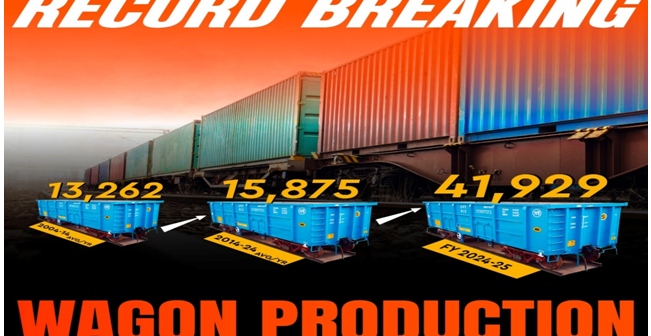Indian Railways has reached an unprecedented milestone with the production of 41,929 wagons during the fiscal year 2024-25, marking an impressive 11 percent year-on-year growth compared to the 37,650 wagons manufactured in the previous fiscal year. This remarkable achievement underscores the government’s commitment to scaling up the nation’s freight infrastructure, as total wagon production over the past three years has reached a staggering 1.02 million units—reflecting a threefold surge compared to the annual average between 2004 and 2014.
The substantial increase in wagon production is set to transform India’s freight capabilities, alleviating transportation bottlenecks and significantly enhancing the efficiency of coal, cement, and steel transport across the country. This leap in manufacturing capacity will not only bolster the Indian economy but also propel the nation closer to achieving its vision of becoming an industrial powerhouse on the global stage.
The government’s efforts to ramp up wagon production align closely with broader national economic goals. By increasing reliance on rail freight and reducing dependence on road transportation, Indian Railways aims to lower logistics costs, cut fuel consumption, and significantly decrease greenhouse gas emissions. This shift holds promise for achieving sustainability targets while simultaneously benefiting businesses and consumers through reduced transportation expenses and minimized inflationary pressures.
In addition to its environmental benefits, the surge in wagon production signals a transformative impact on India’s industrial infrastructure. Improved freight efficiency will support the growth of key sectors, including coal, cement, and steel, which rely heavily on bulk transportation. Faster and more efficient cargo movement is expected to streamline supply chains, reduce delivery delays, and enhance the competitiveness of Indian industries in international markets.
Indian Railways’ wagon production trends over the past two decades illustrate its remarkable progress. Between 2004 and 2014, annual production averaged only 13,262 wagons. This figure rose to an annual average of 15,875 wagons between 2014 and 2024, culminating in this year’s record-breaking achievement. With production levels now exceeding 40,000 wagons annually, Indian Railways is redefining its freight capabilities, setting new benchmarks for efficiency and capacity.
The recent growth trajectory reflects the success of government policies aimed at revitalizing domestic manufacturing and fostering innovation in rail infrastructure. As Indian Railways continues to invest in freight capacity expansion, the nation is poised to strengthen its economic resilience and industrial output. These advancements are expected to have a ripple effect across related sectors, driving job creation, technological innovation, and regional development.
As India’s freight network becomes more robust, the economic implications extend beyond rail transport. Improved connectivity and supply chain efficiency will position India as an attractive destination for global trade, enhancing its standing in the competitive landscape of international commerce.
The achievement of 41,929 wagons produced in 2024-25 underscores the immense potential of Indian Railways to drive economic progress. By addressing key challenges such as freight bottlenecks and logistics costs, this milestone represents a significant stride toward realizing India’s industrial and economic aspirations. As the nation moves forward with its ambitious infrastructure goals, the success of Indian Railways serves as a beacon of progress, showcasing the transformative power of targeted investments and visionary policymaking.





